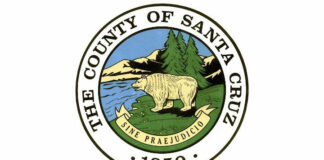Not fully understanding that “it takes strength to ask for help” continues to be one of the biggest obstacles to reducing veteran suicide. Asking for and getting the help a veteran needs is especially difficult for many combat vets trained to take care of others in their unit above all else, and getting their own wounds treated last, according to Viet Nam War veteran Buzz Gray.
Buzz Gray is leading a 22-mile walk between the Veterans Memorial Building in Watsonville to the WWI memorial in downtown Santa Cruz over two days –Saturday, Nov. 10 to Sunday, Nov. 11, Veterans Day-to raise awareness about the crises of veteran’s suicide. The 22 miles signify the appalling statistic that 22 veterans across the country take their own lives every day, and that number has proved difficult to reduce despite improvements to veteran services and outreach.
“Journey for Change” is the name of this event and similar “journeys” that Gray has helped organize over the years. Gray explains the simple act of veterans walking together with families and friends, carrying flags and banners, and encouraging conversations about Post Traumatic Stress Disorder (PTSD) is therapeutic in itself- for the vets who participate and those drawn to talk to participants. The goal is to heighten awareness of high veteran suicide rates, reducing the stigma of mental illness associated with PTSD, and encouraging “the strength to ask for help” among veterans.
According to a report released by the Veteran’s Administration (VA) in September, the suicide rate for veterans was 1.5 times greater than for Americans who never served in the military, accounting for 14 percent of all adult suicide deaths in the U.S. in 2016, although only 8 percent of the country’s population has served in the military. Even so, VA officials reported “great strides in crisis intervention” with the release of the latest data, including expansion of the VA’s crisis hotline and expanded mental health support services.
But Buzz Gray, as well as Dean Kaufman, Veteran’s Service Officer for Santa Cruz County’s Office of Veterans Services emphasize that it is local, face-to-face interaction and word-of mouth referrals that are most effective to “meet the vet where he or she is” and getting them connected to mental health services they may need, as well as many other V.A. benefits that can improve the lives of local veterans who are not necessarily in crises, but could use help.
Kaufman, a Gulf War veteran, explains there are now a wide array of different programs, support groups and activities in the community that are preventing a “one size fits all” approach to mental health services a veteran may need. Kaufman encourages all vets and their families “to get involved, find out what’s happening in the community. It’s when we get the larger community of non-vets involved, especially in reducing the stigma of seeking help for PTSD- that’s when we know we’re getting somewhere,” Kaufman said.
While overcoming the personal resistance to seeking help for PTSD or Military Sexual Trauma remains one of the biggest obstacles, navigating the V.A. bureaucracy and actually receiving the help in a timely manner is another set of obstacles the Veterans Services representatives are dedicated to overcoming. Kaufman explains there is room for optimism, but also room for improvement.
“From the many veterans who have stepped up to help other vets, like Buzz organizing the Journey for Change, and all that’s happening for local vets to get involved, it’s like night and day from where it was eight years ago when I started doing this,” Kaufman said. “But mental health services should be readily available, and we’re working hard to reduce the time between when a veteran walks in and asks for help and when that vet actually begins receiving mental health services. We would like to insure those services are available within two weeks of the initial contact, but we’re not there yet,” Kaufman said.
Kim Monack, Veteran Benefits Outreach Representative for the county’s Veterans Services office, resident of Boulder Creek and mother of three Army veterans, takes a personal approach to her outreach efforts. “There are so many benefits for Vets and spouses, who simply don’t know they might be eligible,” Monack said. “I approach people practically anywhere- if I see someone wearing a vet’s hat, I’ll ask him if he’s service connected,” Monack said.
Monack explains her outreach is taking place in local hospitals, senior living facilities, libraries and churches. This outreach is not only for vets, and not only for mental health services, but for the friends, family and spouses of vets to help them access VA provided health and dental care, education benefits and assistance, employment and housing assistance. Underserved areas like the San Lorenzo Valley and Watsonville are a priority to getting the word out about veteran’s services, according to Kaufman.
More information about the Journey for Change walking event is available on the Facebook page Journey for Change. “We gladly encourage you to join at any point in this journey. Meet us on Sunday at 10:15 at the Santa Cruz Wharf to walk the rest of the way. Wreath laying ceremony (at WWI Memorial, downtown Santa Cruz) to begin 11 am,” according to a flier for the event. More information about the Santa Cruz County Veterans Service Office is available at www.santacruzhumanservices.org/AdultLongTermCare/VeteransServices/ContactUs
Or by calling (831) 454-7276












